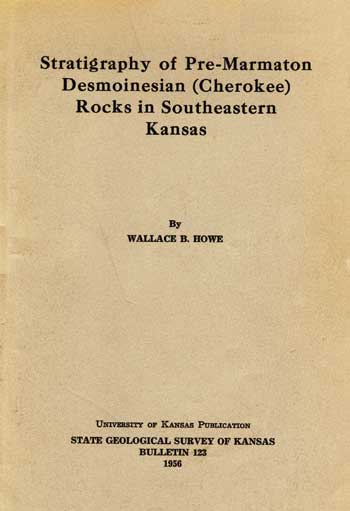Stratigraphy of Pre-Marmaton Desmoinesian (Cherokee) Rocks in Southeastern Kansas
By Wallace B. Howe

Originally published in 1956 as Kansas Geological Survey Bulletin 123. This is, in general, the original text as published. The information has not been updated.
Abstract
This report presents a detailed stratigraphic study of the pre-Marmaton Desmoinesian (Cherokee) beds exposed in southeastern Kansas. The classification applied is that adopted by northern Midcontinent state geological surveys in 1953. Lithologic successions extending from the top of a given coal bed to the top of the next higher coal bed are classed as formations, the formational name given being that of the most prominent unit included. Certain portions of the Cherokee section are not amenable to such division and have received different treatment. The widespread black shale above the Mulky coal and below the basal Marmaton Blackjack Creek limestone has been termed Excello, and by itself constitutes the Excello formation. Altogether, 17 formations, aggregating 450 to 500 feet in thickness, are recognized in the pre-Marmaton Desmoinesian succession in the area. The Krebs subgroup comprises 6 of these formations, and 11 are included in the overlying Cabaniss subgroup. Establishment of the Krebs and Cabaniss subgroups, which together form the Cherokee group, follows recognition of a time-stratigraphic boundary within the succession. The Venteran Substage (including the Krebs subgroup) and the Cygnian Substage (including the Cabaniss subgroup and Marmaton group) are recognized time-stratigraphic subdivisions of the Desmoinesian Series, (Middle) Pennsylvanian System.
Rocks of five persistent lithologic types compose the typical formation within the Cherokee in southeastern Kansas. These are, in upward order: dark shale and dark, irregular limestone; gray shale; underlimestone and sandstone; underclay; and coal. Minor variations of these principal lithologies are useful in identification of individual formations. Especially important are persistent facies of the lower dark shale and irregular limestone division. Underlimestones occur principally in formations classed within the Cabaniss subgroup; they grade laterally from thin, impure, irregular to nodular-bedded limestone to evenly bedded. typically marine limestone. The horizon in each formation at which underlimestone occurs seems to be the position at which additional, possibly nonpersistent cycles of sedimentation may be found in adjacent areas.
Kansas Geological Survey, Geology
Placed on web May 25, 2009; originally published October 1956.
Comments to webadmin@kgs.ku.edu
The URL for this page is http://www.kgs.ku.edu/Publications/Bulletins/123/index.html